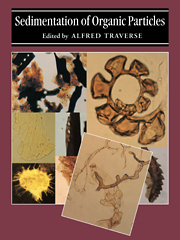Book contents
- Frontmatter
- Contents
- Editor's preface
- List of contributors
- I Introduction
- II Studies of palynosedimentation in modern environments
- III Reconstruction of late Cenozoic vegetation and sedimentary environments from palynological data
- IV Application of data on palynosedimentation to solution of geological problems
- 16 Palynology of sedimentary cycles
- 17 Particulate organic matter, maceral facies models, and applications to sequence stratigraphy
- 18 Association of palynomorphs and palynodebris with depositional environments: quantitative approaches
- 19 A quantitative approach to Triassic palynology: the Lettenkeuper of the Germanic Basin as an example
- 20 Palynomorph concentration in studies of Paleogene nonmarine depositional environments of Wyoming
- 21 Multivariate analyses of palynomorph data as a key to depositional environments of Upper Cretaceous and Paleogene coal-bearing rocks of the western United States
- 22 Relationships between depositional environments and changes in palynofloras across the K/T boundary interval
- 23 Sedimentation of palynomorphs in rocks of pre-Devonian age
- V Appendix
- Index
20 - Palynomorph concentration in studies of Paleogene nonmarine depositional environments of Wyoming
Published online by Cambridge University Press: 06 January 2010
- Frontmatter
- Contents
- Editor's preface
- List of contributors
- I Introduction
- II Studies of palynosedimentation in modern environments
- III Reconstruction of late Cenozoic vegetation and sedimentary environments from palynological data
- IV Application of data on palynosedimentation to solution of geological problems
- 16 Palynology of sedimentary cycles
- 17 Particulate organic matter, maceral facies models, and applications to sequence stratigraphy
- 18 Association of palynomorphs and palynodebris with depositional environments: quantitative approaches
- 19 A quantitative approach to Triassic palynology: the Lettenkeuper of the Germanic Basin as an example
- 20 Palynomorph concentration in studies of Paleogene nonmarine depositional environments of Wyoming
- 21 Multivariate analyses of palynomorph data as a key to depositional environments of Upper Cretaceous and Paleogene coal-bearing rocks of the western United States
- 22 Relationships between depositional environments and changes in palynofloras across the K/T boundary interval
- 23 Sedimentation of palynomorphs in rocks of pre-Devonian age
- V Appendix
- Index
Summary
Introduction
Most quantitative palynologic work uses counts or percentages of taxa (i.e., relative frequency) as the basic measure of occurrence for analysis. Relative frequency has proved satisfactory for most purposes, but it has some undesirable properties. Most notable among these is the closed sum, that is, percentages always sum to 100 and counts sum to a fixed total (basically 100 times a constant). If one taxon goes up in frequency, the remaining taxa as a whole must go down. Percentages, therefore, have an artificial, imposed negative correlation that can distort multivariate ordinations and classifications, and can render common confirmatory statistical analysis such as analysis of variance invalid. Transformations to solve this problem for compositional data in general have been devised (Aitchison, 1986), but involve the logistic normal transformation which uses logarithms of the raw data. Because paleontological data matrices usually contain numerous zeroes, Aitchison's method has to be altered to change zeroes to small positive values. This alteration complicates matters, and the logistic normal transformation has not been used much in paleontology. Use of the logistic normal is treated more fully in Kovach and Batten (Chap. 18 this volume). The complications in using even transformed relative frequency data suggest that other possibilities for measuring quantitative abundance should be examined.
Use of palynomorph concentration (number of grains per unit volume or weight of sediment analyzed) is not common in pre-Quaternary palynology, but has theoretical advantages. Analyses of concentration can be based on total concentration of all palynomorphs or on concentrations of individual taxa in a sample. Concentrations are useful because they may distinguish depositional environments and because concentrations have favorable statistical properties.
- Type
- Chapter
- Information
- Sedimentation of Organic Particles , pp. 431 - 444Publisher: Cambridge University PressPrint publication year: 1994
- 1
- Cited by

